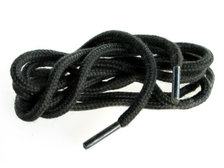Shoelaces
 | Shoelaces (also shoe laces or bootlaces) are thin cords fitted to shoes to prevent the shoe from slipping off by accident. The shoelace can be untied and loosened, permitting the shoe to open wide to admit the wearer's foot; it can then be tightened and knotted. Shoelaces did not become widely popular until the 20th century, previously shoes were slip-on, buckled or buttoned. Buttoned shoes used a special tool, a button hook, to close the buttons but this was slow and difficult. |
Shoe Lace Construction
Traditional shoelaces were made of cotton, jute, hemp or other materials commonly used in the manufacture of rope. Modern shoelaces often incorporate various synthetic fibers, which are generally more slippery and thus more prone to coming undone than those made from traditional fibers. However, synthetic shoelaces often look better and wear longer.
Shoelaces with a flat cross-section are generally easier to hold and stay tied more securely than those with a round cross-section. Very wide flat laces are often called "fat laces". Shoelaces can be coated, either in the factory or with aftermarket products, to increase friction and help them stay tied.
"Twirly" laces are elasticized laces coiled into a tight helix. The twirly laces can simply be pulled tight. When made for children, they come in a large variety of colours and textures. They are also useful for anyone, such as athletes, who have to tie and untie laces quickly.
The small plastic or metal sheath on the end of shoelaces that keeps the twine from unraveling is called an aglet (or aiglet).
Shoelace Tying
Shoelaces can be tied in an almost infinite number of ways. The most common bow, however, is a variant on two half knots tied one on top of the other. A loop is used in the second knot, rather than the simple end of the string, in order to allow for quick untying.
A problem that arises is that two half knots can be tied together in two different ways (ignoring symmetrical configurations). One addition of a half knot to a half knot forms a square or reef knot, an altogether uninspiring knot for the knot aficionado, but a fairly effective one for the purpose of tying shoelaces. While a fairly insecure knot, it functions best when laid flat against a surface as it is on a shoe. The second combination of half knot to half knot gives a granny knot, a knot not good for tying shoes as it does not lay flat against a surface. It is terribly insecure, and most people who use it will find themselves retying their shoelaces many times a day.
Much discussion has appeared on shoelace tying websites discussing this issue and why it appears that the large majority of people (75% according to one website) are using the granny knot. Some have suggested that it may have to do with children watching their parents and mirroring them, but a total mirroring would produce, if the parent were tying a square knot, a mirror image square knot. A simpler explanation is that if one ties shoelaces first by tying a half knot and then by forming two loops and tying another (as opposed to some speedier technique), and if one consistently puts one hand over the other (left over right or right over left) one gets a granny knot. A square knot is the less intuitive knot and requires switching the top hand. First left over right and then right over left, or first right over left and then left over right. You can generally tell if you have produced the square or granny knot by the direction in which the loops lie. If they lie side to side, you have probably made a square knot. If they lie front to back, you have probably made a granny knot and should teach yourself the other.
Informal experiments seem to show that the need for retying shoelaces will drop dramatically with the square knot.
Shoe Lacing
This refers to the process of running the shoelaces through the holes, eyelets or lugs to form the closure of the sides of the shoe. Mathematically, there is an almost infinite number of possible ways of lacing. The most common method, termed "Criss Cross Lacing", is also one of the strongest and most efficient, especially compared to other more decorative methods that are generally more difficult to tighten or loosen. One of the most popular decorative methods, termed "Checkerboard Lacing", is actually near impossible to tighten or loosen, thus the shoe is effectively considered to be a "slip-on". Various methods of "Straight Lacing" (also known as "Bar Lacing") are also very popular, especially on dress shoes where the sides of the shoe come together in the middle.
Shoe lacing methods are also chosen for their functional benefits. For example, being faster or easier to tighten or loosen, binding more tightly, being more comfortable, using up more lace or less lace, adjusting fit, preventing slippage.
Using standard shoes and standard shoelaces, a process patent was granted for lacing in a double-helix pattern "resulting in reduced friction and faster and easier tightening and loosening". Another process patent was issued for an alternative way of tying shoelaces.
Shoelace Accessories
There are many shoelace accessories. There are hooks to help lace shoelaces tightly. They are especially useful for skates where tight lacing is important. Shoelace covers protect the laces, especially in wrestling. Shoelace charms are decorative, as are coloured shoelaces. Some dress codes (e.g. high schools) will specifically exclude colour laces and charms. Lacelocks hold laces together, eliminating the need for tying. There are shoelace tags, with two holes through which the shoelace is passed. These are worn on the section of shoelace closest to the toes so that the image or writing on the tag is visible.
External links
